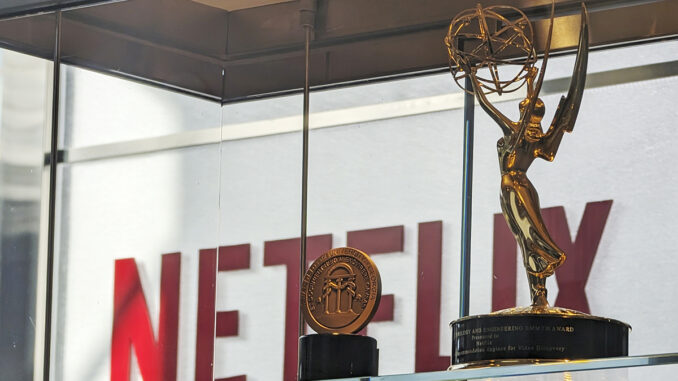
LOS GATOS, Calif.— Although its video streaming service sparkles with a Hollywood sheen, Netflix still taps its roots in Silicon Valley to stay a step ahead of traditional TV and movie studios.
The company, based 300 miles away from Hollywood, frequently reaches into its technological toolbox without viewers realizing it. It often just uses a few subtle twists on the knobs of viewer recommendations to help keep its 270 million worldwide subscribers satisfied at a time when most of its streaming rivals are seeing waves of cancellations.
Even when hit TV series like “The Crown” or “Bridgerton” have wide appeal, Netflix still tries to cater to the divergent tastes of its vast audience, which may include tailoring summaries and trailers about its variety to please different audiences.
For an Oscar-nominated film like “Nyad,” a lover of action might see a trailer of the title character immersed in water during one of her epic swims, while a comedy fan might see a lighthearted scene featuring some amusing banter between two familiar stars.
Netflix can pull off these variations through the deep understanding of viewing habits it gleans from crunching the data from subscribers’ histories with its service — including those of customers who signed up in the late 1990s.
“It is a secret sauce for us, no doubt,” Eunice Kim, Netflix’s chief product officer, said while discussing the nuances of how Netflix tries to reel different viewers into watching different shows. “The North Star we have daily is to keep people engaged, but also ensure they are incredibly satisfied with their viewing experiences.”
Last year, video streaming services collectively suffered about 140 million account cancellations, a 35% increase from 2022 and nearly triple the volume in 2020, when the COVID-19 pandemic created a boom in demand for entertainment from people corralled at home, according to numbers compiled by the research firm Antenna.
Netflix doesn’t disclose its cancellation or churn rate. Still, last year, its streaming service gained 30 million subscribers — marking its second-biggest annual increase behind its growth spurt during the 2020 pandemic.
Part of last year’s subscription growth flowed from a crackdown on viewers who had been freeloading off Netflix subscribers who shared their account passwords. But the company is also benefiting from the technological know-how that helps it to keep funneling shows to customers who like them and make them think the service is worth the money, according to J. Christopher Hamilton, an assistant professor of television, radio and film at Syracuse University.
“What they have been doing is pretty ingenious and very strategic,” Hamilton said. “They are ahead of the legacy media companies trying to do some of the same things but just don’t have the level of sophistication, experience, nor the history of the data in their archives.”
Netflix’s nerdy heritage was once mocked by an entertainment industry that looked down on the company’s geekdom.
“It’s a little bit like, is the Albanian army going to take over the world?” former Time Warner CEO Jeff Bewkes said of Netflix during a 2010 interview after being asked about the threat Netflix posed at the time.
Not long after that put-down, Netflix began mining its viewing data to figure out how to produce a slate of original programming that would attract more subscribers — an ambitious expansion that forced Time Warner (now rolled into Warner Bros. Discovery) and other long-established entertainment companies such as Walt Disney Co. into a mad scramble to build their own streaming services.
Netflix’s use of technology to retain subscribers to boost its fortunes — the company’s profit rose 20% to $5.4 billion last year — is now widening the divide with rival services still trying to stanch their losses.
Disney’s 4-year-old streaming service recently became profitable after an overhaul engineered by CEO Bob Iger, but he thinks more work will be required to catch up with Netflix.
“We need to be at their level regarding technology capability,” Iger said at a conference earlier this year. “We’re creating and developing all that technology; obviously, the gold standard there is Netflix.”
If Netflix’s data shows a subscriber has watched a lot of Hindi productions, it would be almost a no-brainer to feature clips of Bollywood actress Alia Bhatt in a role she played in the U.S. film, “Heart of Stone” instead of the movie lead actress Gal Gadot.
“We want to do a really good job putting the things that you prefer in front of you,” Kim said. “Part of that is the content recommendations themselves, but it’s also about how we present the content to you.”



